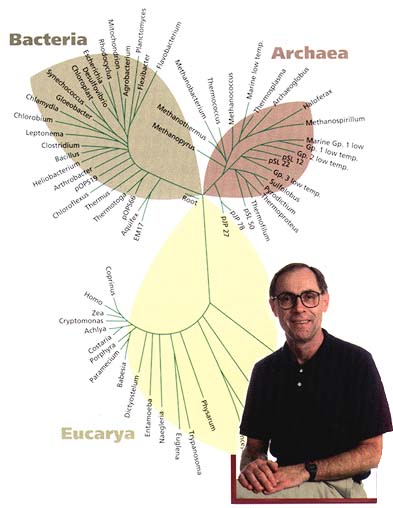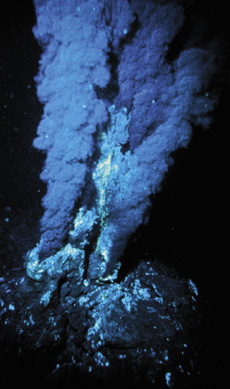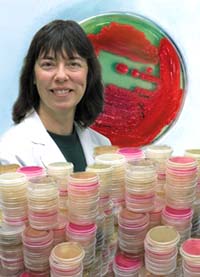The Tree of Life
 |
|
|
|
In the ocean, right at the sediment surface, you find about a billion single-celled organisms per gram," says Norman Pace, a member of CEB and the Life Sciences Division's Environmental Biology Department. Pace is also professor of Plant and Microbial Biology, and of Molecular and Cell Biology, at UC Berkeley. "Go down 500 meters, and there are still ten million cells per gram. Add up what's in just the top 500 meters of sediments, and you account for 10 to 20 percent of global biomass."
Yet, says Pace, "when you say 'diversity of life,' most people think of palm trees, mushrooms, whales, fleas-big stuff. Unfortunately, many very prominent biologists still think that way. Squish any insect and you'll find hundreds, maybe thousands of distinct species of microbes, many of them unknown." Pace acknowledges that one reason microbes have been ignored is that they are hard to see. "Ninety-five percent of life in the oceans is less than two micrometers in diameter." What's more important, "taxonomists have always relied on physical traits, but in microbes these are very misleading. A few basic shapes, mostly rods and spheres, tell you nothing. Even close relatives can have completely different metabolic systems-some eat glucose, some eat light, some are switch hitters." Classification is crucial to understanding evolution, but it was a misplaced reliance on physical traits that produced the familiar, erroneous, "five kingdoms of life" still widely taught, a classification featuring animals, plants, fungi, protists (or protozoa) and monera (bacteria). All members of the first four kingdoms are eukaryotes, with nuclear membranes; members of the last kingdom, without nuclear membranes, are called prokaryotes. "I find the notion of the prokaryotic nonsensical," says Pace. "Distinguishing organisms on the basis of whether or not they have a bag around the cell nucleus is not much more helpful than distinguishing animals by their skin color." The chief problem with the five-kingdom view is that it presents evolution as a ladder, with primitive creatures at the bottom and advanced creatures at the top. "Every species alive today has been perfected for its niche through millions of years of evolution. Evolution is a radiation, not a ladder." But to realize that, Pace says, it took the work of University of Illinois biophysicist Carl Woese, who painstakingly developed a method of establishing evolutionary relationships by studying differences in sequences of ribosomal RNAs-nucleic acids abundant in cells, which are highly conserved and found in all organisms from bacilli to blue whales. Using molecular methods, Woese came to realize that most kinds of life on Earth are microbial. He also discovered that besides the eukaryota and bacteria there was a third major domain of life, lacking some genetic sequences characteristic of all other life, possessing others found nowhere else-and with no bag around the nucleus. At first Woese dubbed the third domain "archaebacteria," but later shortened the name to archaea. |
|
|
|
"I'm shocked at my own opinion of the distribution of life just two decades ago," says Norman Pace, who was an evolutionary traditionalist when he encountered Woese's work in the late 1970s. "I now consider Carl Woese to be the greatest biologist since Darwin." Pace has developed ways of using RNA sequencing and other molecular methods to characterize and study relationships among microbial communities without having to cultivate them in the laboratory, garnering results that have underscored microbial diversity. He and his colleagues have also sought to determine the limits of Earth's habitable zone, concentrating on microbes living in high-temperature environments such as hot springs, deep-sea vents, and the deep subsurface. Pace's work has led to an elaboration of Woese's new, radiant map of evolution. Among other things, it confirms that although the organelles-mitochondria and chloroplasts-of animals, plants, and fungi derive from bacterial symbiotes, eukarya and archaea split off from bacteria long before this, and evolved together. Like most archaea and many bacteria, our common ancestor may well have been a denizen of the dark subsurface, a heat lover and hydrogen breather that lived wherever water (if only once in a long while) could react with iron in basalt. Wherever a little hydrogen and carbon and a few other chemicals are available-and where the mix is occasionally stirred by earthquake or volcanos-microbes maintain a foothold and evolve. "Life is driven by the groanings of the planet," Pace says, "not by the turnings of the sun." An enormous volume of the Earth's crust is thus a candidate nursery, and so too the subsurface of other moons and planets-places where meteorite storms, ice-encrusted oceans, howling dry infernos, or freezing gossamer atmospheres make the notion of a "warm little pond" a pleasant fantasy.
SIDEBAR:
Inside the Earth, Outside the Box
 |
| Jennie Hunter-Cevera leads
the Center for Environmental Biotechnology. |